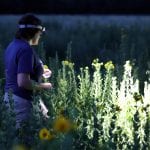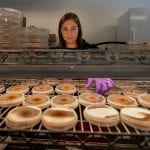
Ecological Intensification & Perennial Polyculture
Ecological intensification aims to harness ecological processes in order to keep pests in check, maintain fertility and prevent loss of soil, nutrients, and organic matter.
Our researchers believe that perennial polycultures offer previously unattainable levels of ecological intensification in agriculture. This contrasts with the advent of chemical-based input intensification that was responsible for increased yields in industrial agriculture last century.
Why Ecological Intensification?
- Plant diversity is important because it helps to keep populations of plant-loving insects and diseases in check.
- Diversity also tends to enhance productivity because resources such as sunlight, water, and nutrients are used more efficiently when species with different resource requirements grow together.
- Perenniality is important because when vegetation lives for many years, soils are not only protected against erosion, but they actually build and accumulate organic matter.
- Deep-rooted perennial plants are able to access nutrients and water that escape the reach of annual plants.
- With the intercrop systems, called polycultures, The Land Institute hopes to incorporate the benefits of diversity seen in nature.
- Ecological Intensification harnesses ecological processes to supplant the need for commercial inputs like fertilizers and pesticides.
- Researchers believe that by combining perennality and diversity in grain agriculture, levels of ecological intensification that were previously unachievable will effectively address many problems inherent in annual agriculture—including severe pest outbreaks, soil erosion, nutrient leakage and soil organic matter loss.

Jarrod Fyie, a resident at The Land Institute, harvests mixed plants sharing a test plot. The biomass will be analyzed as part of a goal to grow multiple crops in the same field.
Ecological Instensification Programs
At The Land Institute, we are working to combine plantings of complimentary perennial species in “intercrops” or “polycultures” and examine the critical functions of natural systems into agriculture: nutrient retention, carbon sequestration, and soil regeneration, and other indicators of soil health.
Additionally, The Ecology Team is learning how we can use crop diversity paired with biological control agents to manage pests and pathogens in our perennial crop systems.
Project Team

Tim Crews
Chief Scientist; Director of the International Initiative

Ebony Murrell
Lead Scientist, Crop Protection Ecology

Kathryn Turner
Lead Scientist, Crop Protection Genetics

Edy Chérémond
Lab Manager, Crop Protection Ecology

Madeline DuBois
Lab Manager, Soil Ecology

Eric Cassetta
Phenomic Breeding Technician

Yvonne Thompson
Research Associate, Crop Protection Genetics
Related Scientific Publications
Fire Frequency Driven Increases in Burn Heterogeneity Promote Microbial Beta Diversity: A Test of the Pyrodiversity-Biodiversity Hypothesis
Researchers conducted a study at the Perennial Agriculture Project (PAP) Field Station (a joint venture between The Land Institute and The Malone Family Land Preservation Foundation) in Lawrence, Kansas to observe how…
Intercropping Alters Phytochemicals Associated With Insect Herbivory
Ebony Murrell, Lead Scientist in Crop Protection Ecology, collaborated with former Land Institute researchers Chase Stratton and Jarrod Fyie and USDA-ARS researcher William Morrison on a study assessing the impact…


 Our
Our 